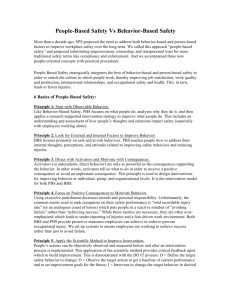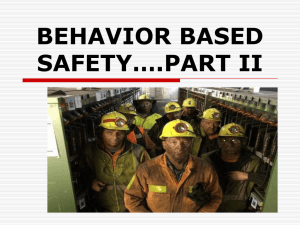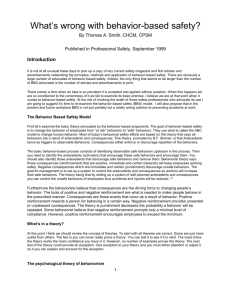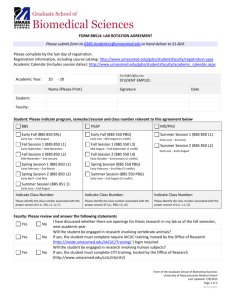July Meeting – Behavior Based Safety Presentation
advertisement
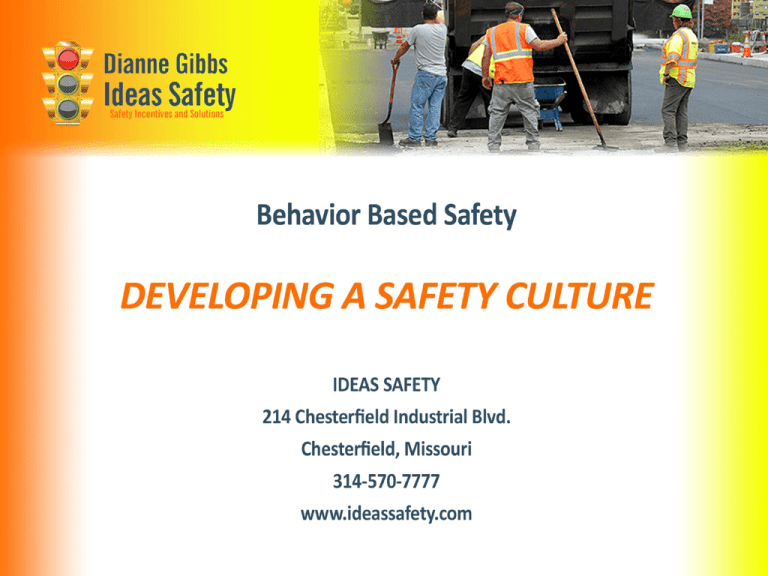
BBS – Behavior Based Safety • What is Behavior Based Safety • History • Successful Programs • How Behavior Based Safety Works • Criticisms • Future • Technology Available • References What Is Behavior Based Safety? Behavior Based Safety (BBS) is the “application of science of behavior change to real world problems.” BBS “focuses on what people do, analyses why they do it, and then applies a research – supported intervention strategy to improve what people do. At its very core BBS is based on a larger scientific field called Organizational Behavior Analysis. HISTORY Originated with the work of Herbert William Heinrich in 1930 with Travelers Insurance Company. Reviewed thousands of accident reports completed by supervisors. Drew the conclusion: • Most accidents, illnesses & injuries in the workplace are directly attributable to man-failures and unsafe actions of workers. Classified: • Man-failures • Unsafe actions of workers Classified the accidents: • 73% man-failures Re-classified the accidents: • 83% of all accidents, injuries and illnesses are caused by worker errors. Heinrich’s data does not tell why the person did it, just that the accident occurred. His conclusion – 90% of incidents caused by human error. The Phrase “behavior-based safety” (BBS) was coined by Dr. E. Scott Geller of “Safety Performance Solutions” in 1979. SUCCESSFUL PROGRAMS To be successful a BBS program must include: • All Employees – CEO to floor associates • A change in policy, procedures and/or systems to achieve changes in behavior • Buy in and support from all involved in decisions • A basis of scientific knowledge ELEMENTS How Behavior-Based Safety Works A good BBS program will consist of: • Common Goals – Employee and Managerial involvement in the process. • Definition of what is expected – Specification of target behaviors derived from safety assessments. • Observational data collection. • Decision about how best to proceed based on those data. • Feedback to associates. • Review BBS is not a quick fix. It is a commitment. The Goal is always the same. ELIMINATE INJURY ! HOW BEHAVIOR-BASED SAFETY WORKS • Observation at Site • Worker Permission • Monitors Worker – Documents Safe Behaviors Monitors At-Risk Behaviors • Feedback – Explains at Risk Behaviors Asks Why Discussion Recommendations Commendable Comments on Safe Behavior Understood At-Risk Behavior – No Reprimand or Penalties. Check List Filled Out Workers Name is Not Noted on Checklist Data Collected for Later Detailed Analysis Feedback Provided to Workers and Management HOW BEHAVIOR-BASED SAFETY WORKS (continued) Electronic Database • • Data Entry - Data Gathering - Preliminary Reports - Observation Checklists Reports - Analyze - Recommend Solutions - Trends of At-Risk Behaviors - Feedback Reports – Weekly, Distributed to Workers BBS Steering Committee – chaired by management, high-level, influential employees • • • Discuss and Analyze BBS findings. Produces a Set of Recommendations to Tackle Worker Behaviors. Implement Solutions. CRITICISMS Donald J. Eckenfelder stated he felt that BBS has virtues but lasted too long and cost too much. He felt that it has been used incorrectly turning the process into a hindrance instead of a help. Some think that BBS has outlived its usefulness – no examples were given. Article published by Professor Dominic Cooper – on a survey of 247 companies implementing BBS – No Evidence had been put forward to support these critical assertions. • Evidence points to positive outcomes • 92% of respondents wanted to work at a company using BBS James Reason’s Cheese Model – • All accidents are preventable if you trace the root cause back management decisions, leadership and actions. UK’s Tim Marsh insist that an understanding of the underlying cause of the unsafe act or condition rather than a focus on the individual is the key to effective long term behavior change. FUTURE Look to the Future Use BBS a predictive analytics to anticipate where your next injury may occur. • • • • • Real-time data. Observation intelligence through analytics. Understand patterns and trends. Identify where the next accident/incident could occur. Accuracy Rates as High as 86%. BBS Predictive Analytics helps organizations work toward the goal of reducing accidents and eliminating death on the job. TECHNOLOGY AVAILABLE DuPont™ STOP™ For more than 30 years DuPont STOP has been helping organizations prevent injuries and accidents through behavioral safety training programs. For increasing safety awareness in the workplace and helping coworkers talk with each other about safety, DuPont was awarded the 2007 Excellence in Safety Training Award by “HR Workplace and Safety Magazine.” Behavior-based safety programs are available for both supervisors and employees. Training involves a combination of methods, including individual self-study, field, activities and group meetings. Programs include: STOP For Supervision, STOP For Each Other, STOP For Oil and Gas and STOP For Ergonomics. Supporting products and services include STOP Implementation Assistance Workshops, STOP Assessment Service and STOP DataPro. For more information go to: www.training.dupont.com/dupont-stop TECHNOLOGY AVAILABLE (continued) S&W TECHNOLOGIES S&W Technologies has over two decades of experience creating easy-to-use, high value behavior based safety software solutions that improve operational and safety conditions for nuclear plants, commercial and industrial facilities, construction companies, and educational institutions. Their Behavior Based Safety software solutions are highly flexible and provide documented cost and time savings and reduce workplace injuries by improving customer’s business process. Software: • Capture, Track and Report observations & inspections at a site, region or corporate level • Identify and mitigate risks in real-time to reduce incidents • Record data easily via the web or handheld mobile devices • Use Guardian SafeScan to eliminate manual data entry of paper checklists • Share best practices between locations • Create unlimited number and variety of customized checklists • Assign and track action items to closure • Use the Guardian Dashboard as a daily monitor to track key safety metrics • Generate detailed reports by site and rollup reports across the company • Schedule any report to be automatically generated and delivered to anyone • Link to the Guardian Incident Tracking System to analyze leading and lagging indicators For more information go to: www.swtechnologies.com REFERENCES 1. Staff. "Introduction to Behavioral Safety" Cambridge Center for Behavior Studies. 2. Geller, E. Scott (2004). "Behavior-based safety: a solution to injury prevention: behavior-based safety 'empowers' employees and addresses the dynamics of injury prevention." Risk & Insurance. 15 (12, 01 Oct) p. 66 3. Matthews, Grainne A. "Behavioral Safety from the Consumer's Perspective: Determining Who Really Provides Behavior safety." Cambridge Center for Behavioral Studies. 4. Sulzer-Azaroff, Beth. "Safe Behavior; Fewer Injuries." Cambridge Center for Behavior Studies. 5. Geller, E. Scott (1998). Working Safe: How to help people actively care for health and safety. However, changing attitudes in the medium to long term specifically is often difficult and the work of researchers such as Sidney Dekker, Tim Marsh and James Reason has stressed the importance of addressing workforce behaviours from a environmental/ cultural/ root cause perspective - first seeking to change the environment rather than the person. This mapping directly onto the "safety hierarchy" of designing the risk out being preferable to such as supervision and PPE. (See also under "criticisms of BBS" below). Lewis Publishers 6. Cooper, Dominic. (2009) Behavioral Safety Approaches: Which are the most effective 7. Cooper, M.D. (2010). Return on Investment of Behavior-Based Safety 8. Al-Hemoud, Ali M., Al-Asfoor, May M. (2006) "A behavior based safety approach at a Kuwait research institution." Journal of Safety Research, 37 (2) pp. 2001–2006. 9. SEMCOSH Fact Sheet: Behavior Based Safety (2004) 10. Atkinson, William (2005). "Behavior-based safety." MC (Manufactured Concrete) Magazine May/June. 11. Cooper, M.D.; Farmery, K.; Johnson, M.; et al., (2005). "Changing Personnel Behavior to Promote Quality Care Practices in an Intensive Care Unit," Therapeutics and Clinical Risk Management, 1(4), 321–332. 12. Roman, H.R. & Boyce, T.E. (2001) Institutionalizing Behavior-Based Safety: Theories, Concepts, And Practical Suggestions. The Behavior Analyst Today, 3(1), 76–82 BAO 13. Geller, E-S. (2001) Behavioral Safety: Meeting the Challenge of Making a Large-Scale Difference. The Behavior Analyst Today, 2(2), 64–75 BAO 14. Malallah, S. (2008). CHANGING WORKERS' BEHAVIOR: Research – Methodology – Implementation. Kuwait. 15. Eckenfelder, Donald J. (2004) "Behavior Based safety: a model poisoned by the past; based on obsolete thinking, behavior based safety." Risk & Insurance 15 (12) p. 65 16. Cooper, M.D. (2003) "Behavior Based Safety Still A Viable Strategy," Safety & Health April, pp. 46–48. ADDITIONAL READING • Behavior Based Safety Case Studies Center for Behavioral Safety • Focus on Behavior to Manage Risk the Right Way Dr. Thomas E. Boyce • Behavior-Based Safety Aubrey Daniels International • What is Behavior Based Safety? Aubrey Daniels International • Behavioral-Safety.com • Krause, Thomas R. Leading With Safety. Hoboken, NJ, Wiley Publishing Company, 2005. • Cambridge Center for Behavior Studies. [1] • Dell, Geoff (1999). "Safe Place vs. Safe Person: A Dichotomy, or Is It?" Safety Science Monitor 3, Article 14, Special Addition. • Galloway, Shawn (2008) "Critical Questions to Improve Behavior Based Safety" Safety Culture Excellence. [2] • Geller E.S. The Psychology of Safety: How to Improve Behaviors and Attitudes on the Job. Radnor, PA, Chilton Book Company, 1996. • Hartford Loss Control Department (2002). "About Behavior-Based Safety Management." The Hartford Loss Control Tips, Technical Information Paper Series. TIPS S 520.019. • Marsh, T (2008). Affective Safety Management. IIRSM. • Marsh, T (2011). Talking Safety. Ryder-Marsh. • Lopez-Mena, L. (1989) Intervencion psicologica en la empresa (in Spanish) Barcelona: Martinez Roca Ed. (see also [www.persist.cl]) • Mathis, Terry (2005) "Lean Behavior-Based Safety – How the Process is Evolving to Survive in Today's Economy" Occupational Hazards. [3] • Quality Safety Edge. BSN 2009 (Behavioral Safety Now). [4] • Safety Culture Excellence. [5] • Vinas, Tonya (2002). "Best Practices – DuPont: Safety Starts at the Top." IndustryWeek.com. 1 July. [6] • Wilson, Larry (2007) BEHAVIOR BASED SAFETY "The Construction Industry Experience" safetyxchange.org • Cooper, Dominic (2009) Behavioral Safety: A Framework for Success. [7] • The Safety Institute of America (www.safetyinstituteofamerica.com/news)

